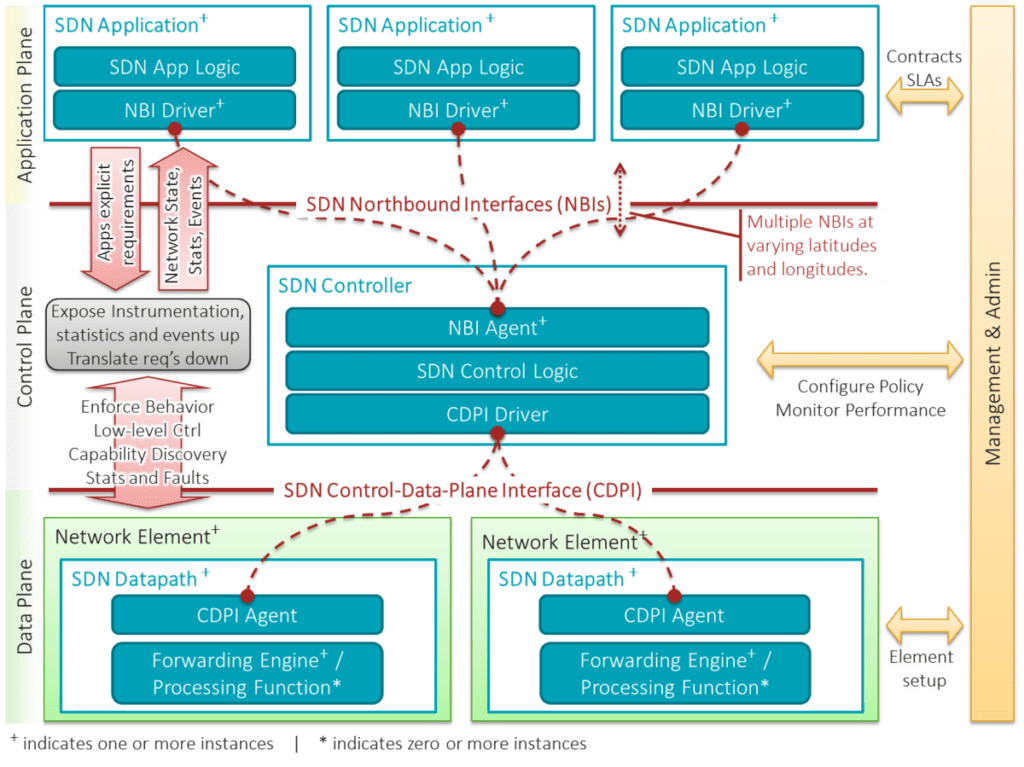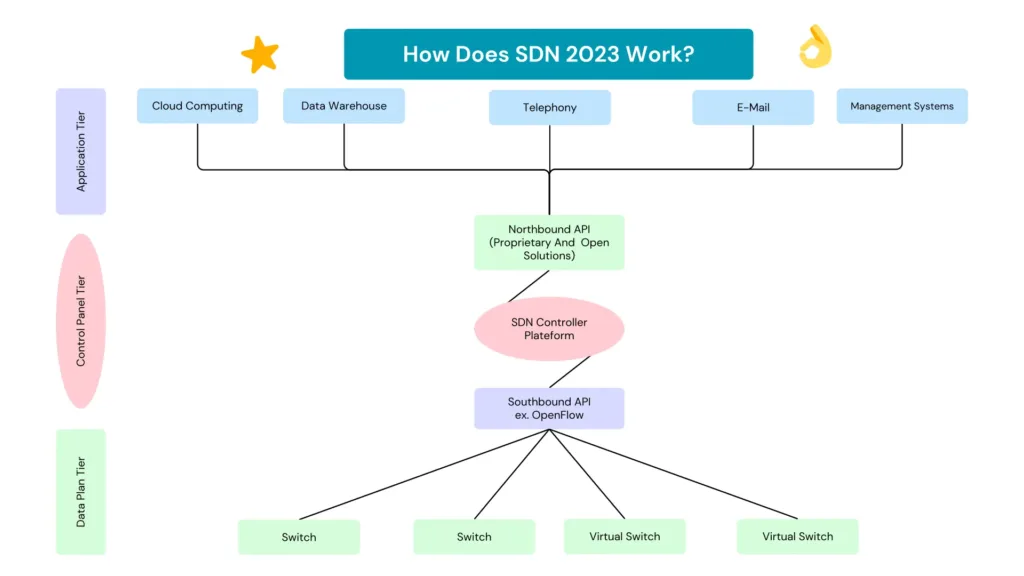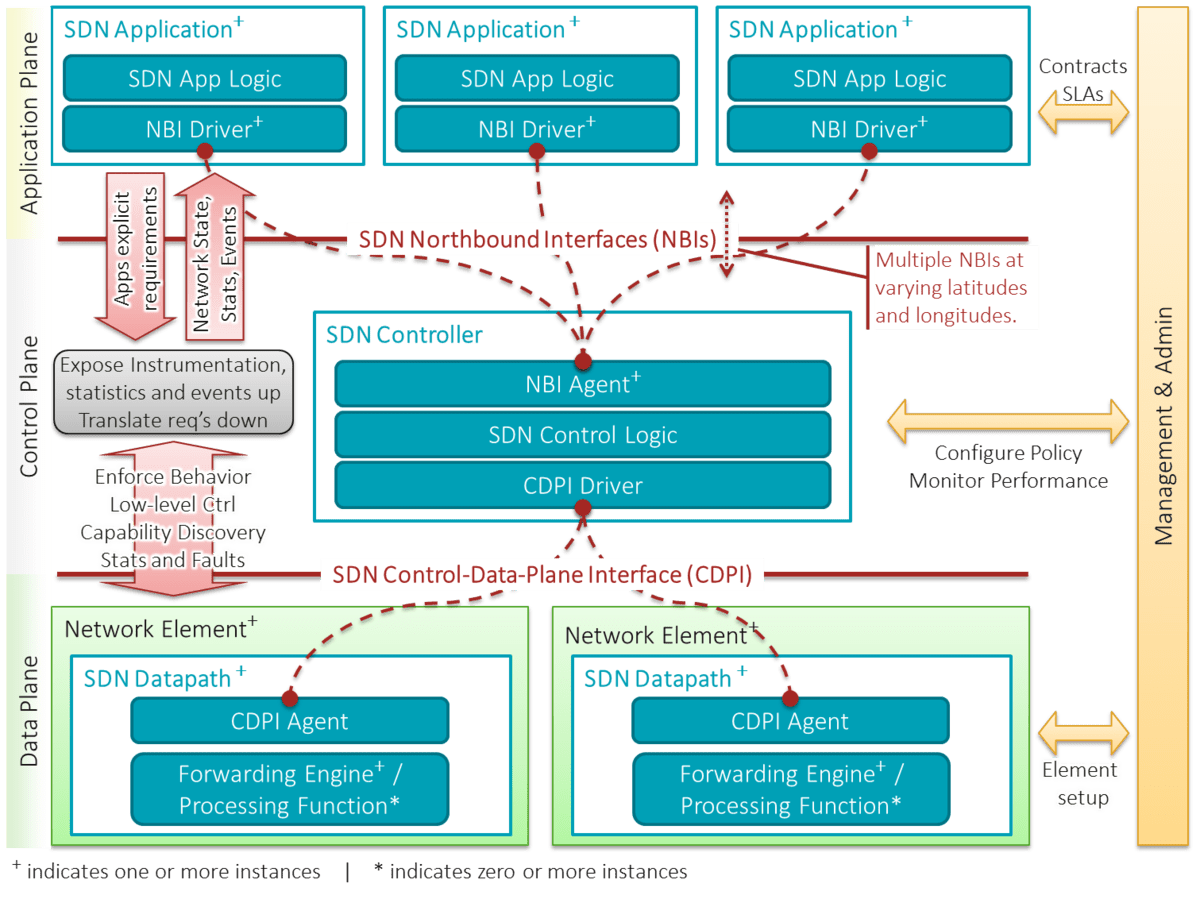Contents
- 1 What is Software Defined Networking (SDN 2023)?
What is Software Defined Networking (SDN 2023)?

Benefits Of SDN Anesthesia 2023
There are many benefits of SDN 2023 uses, including:
Increased agility:
Improved security:
Reduced costs:
Performance:
Scalability:
There are also some challenges associated with SDN, including:
SDN 2022 2023 Challenges
Complexity:
Security:
Interoperability:
Vendor lock-in:
Learning curve:
How Does SDN Work?

- SDN works by using a software-based controller to manage the network’s traffic.
- The controller communicates with the network’s devices using northbound APIs, and it uses southbound APIs to communicate with the devices’ data planes.
- The SDN controller uses a set of rules or protocols to determine how traffic should flow through the network, these types of rules or protocols can be used on different kinds of factors which are the type of traffic, the source and destination of the traffic, and the priority of the traffic.
- The controller sends these rules to the network’s devices, and the devices use these rules to forward traffic.
- This allows the SDN controller to centrally control the whole network’s traffic, which makes it easier to manage and easier to troubleshoot the whole network.
SDN 2023 Components
There are three main components of SDN:
The controller:
The controller is the software-based component that manages the network’s traffic.
The devices:
The devices are the network’s physical infrastructure, such as switches and routers.
The APIs:
The APIs are the interfaces that allow the controller to communicate with the devices and the applications that use the network.
SDN 2023 Applications
There are different types of applications that can be used with SDN, including:
Network traffic management:
SDN can be used to manage network traffic, such as by prioritizing traffic, load balancing traffic, and preventing congestion.
Security:
SDN can be used to enhance the security of the network which enforces security policies and preventing unauthorized access to the network.
Automation:
SDN can be used to automate network tasks which are provisioning new devices, configuring devices, and troubleshooting problems.
SDN 2023 Architecture
SDN architecture is typically divided into three layers: the control plane, the data plane, and the application layer.
The control plane is responsible for making decisions about how traffic should flow through the network. It does this by using a set of rules, called a flow table. The flow table is a type of database that contains multiple information about the network’s topology. And also shows the types of traffic that are allowed to flow through the different networks and the priority of that traffic.
The data plane is responsible for forwarding traffic according to the rules in the flow table. It does this by using a set of forwarding tables. The forwarding tables contain information about the links between network devices, and the next hop for each destination address.
The application layer is responsible for interacting with the control plane. It does this by using a set of APIs. The APIs allow applications to request changes to the flow table, and to monitor the status of the network.
SDN Open Standards
There are a number of open standards that are being developed for SDN, including:
OpenFlow:
OpenFlow is a standard for communicating between the control plane and the data plane.
ODL:
ODL is an open-source SDN controller.
CORD:
CORD is a project to develop a common open platform for SDN.
ONF:
The Open Networking Foundation is a non-profit organization that promotes the development of SDN.
These standards are helping to ensure that SDN solutions from different vendors can interoperate. This is essential for the widespread adoption of SDN.
SDN 2023 Use Cases
SDN is already being used in a variety of use cases, including:
Cloud computing:
SDN can be used to improve the performance and scalability of cloud computing networks.
Internet of Things (IoT):
SDN is used to manage the large amount of device that are connected threw the Internet of Things (IoT).
5G networks:
SDN can be used to improve the performance and scalability of 5G networks.
Virtualized networks:
SDN can be used to create and manage virtual networks. This can help us in the businesses to improve the agility and flexibility of their networks.
SDN 2023 Future
In this new era, SDN is a rapidly evolving technology, and there are many exciting possibilities for the future of SDN.
Some of the potential future trends of SDN include:
Increased adoption:
SDN is still a relatively new technology, but it is gaining momentum. As the benefits of SDN become more widely known, we can expect to see more businesses adopt this technology.
More open standards:
The development of open standards is essential for the widespread adoption of SDN. As more open standards are developed, we can expect to see more interoperability between SDN solutions from different vendors.
New applications:
As SDN continues to evolve, we can expect to see new applications for this technology.
Some of the potential future applications of SDN include:
Self-driving cars:
SDN can be used to manage the network traffic of self-driving cars. This will help to ensure that self-driving cars can communicate with each other and with the infrastructure around them.
Smart cities:
SDN can be used to manage the network traffic of smart cities. This will help to ensure that smart cities can operate efficiently and securely.
Healthcare:
SDN can be used to manage the network traffic of healthcare organizations. This will help to ensure that healthcare organizations can provide uninterrupted care to patients.
SDN 2023 Security
SDN’s centralized control plane makes it a potential target for cyberattacks.
security measures that can be taken to protect SDN networks, including:
This will help to prevent unauthorized access to the control plane.
Encrypting network traffic:
This will lessen the chance that sensitive information will be intercepted.
By utilizing intrusion detection and prevention systems, cyberattacks can be recognised and minimised.
Keeping the software up to date:
This will help the software to be up to date on the known vulnerabilities.
By taking these security measures, organizations can help to protect their SDN networks from cyberattacks.
Conclusion
SDN is a potent technology with the ability to completely alter how networks are managed and run. SDN, however, is still a young technology and has some difficulties. As SDN matures, we can expect to see these challenges overcome, and SDN will become a more widely adopted technology.
Featured Image Credit: Open Networking Foundation (ONF)
Frequently Asked Question’s (FAQ’s)
Q.1 What is software-defined networking (SDN 2023)?
The control plane and data plane are divided in a network architecture known as software-defined networking (SDN 2023). The control plane is responsible for making decisions about how traffic should flow through the network, while the data plane is responsible for forwarding traffic according to those decisions.

